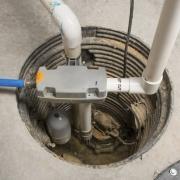How to Install a Sump Pump
A water-driven pump draws water into a building by pumping up and draining it outdoors. People often use pumps in basements to prevent flood damage. Water-powered pumps are affordable and can be easily installed by any do-it-yourselfer as long as they have the right tools and the right knowledge. However, it is a slow job so you should make sure that flooding is not caused by problems like clogged gutters or drainage water.
Instructions
- Determine the best place for the sump pump. Locate major water and sewer lines to avoid damaging them during installation. The pump should be near an outer wall if possible and should be easily accessible.
- Break out of the concrete at the lowest point of the floor using a pneumatic hammer. Cut a section 6 inches wider than the plastic liner. Place the liner in the hole so that the top is level with the basement and fill the space around the cover with gravel. Apply cement with a trowel for the space between the edge of the pit and the plant.
- Drill a hole in the outer wall next to the sump pump. Make sure that the diameter of the hole is the width of the discharge pipe. Place the discharge pipe into the hole you drilled and use a caulking gun to seal around it.
- Plug the electrical cords of the water sump pump for the vertical tube with insulation tape. Connect the discharge to the pump and place the pump in the bottom of the hole. Position the pump so that the float is several inches away from the line. This is for easy and smooth movement.
- Place the liner cap on the lift. Use PVC pipe to connect the discharge to the discharge pipe that is located in the hole in the outer wall. Place the check valve that comes with the water sump pump between the discharge port and the PVC pipe that extends from the discharge pipe. The check valve is used to prevent it from burning the pump motor. Seal the pipe connections with PVC cement.
- Test the sump pump by pouring about five gallons of water into the liner.
Tips & Warnings
- Be sure to run the pump for several minutes from time to time to make sure it is still working, especially before a rainy season.






